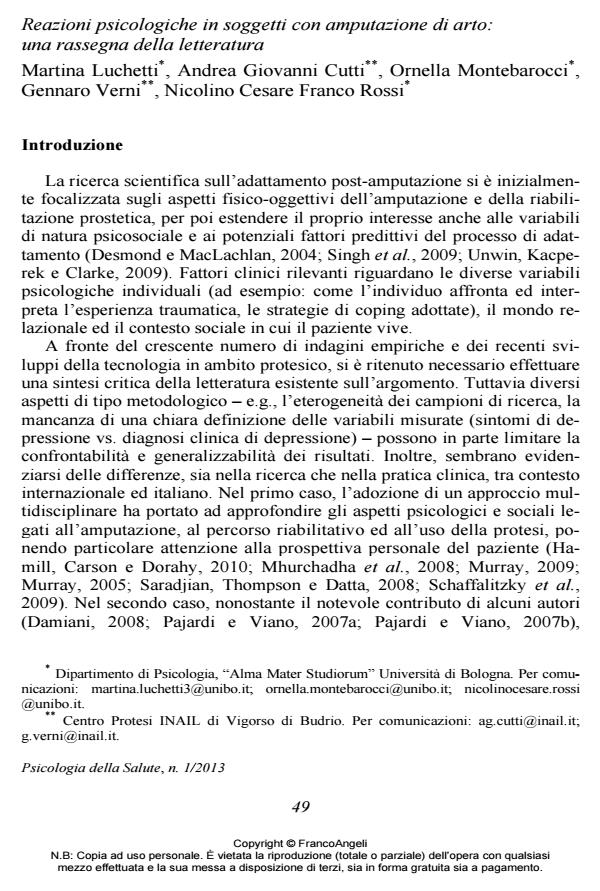Reazioni psicologiche in soggetti con amputazione di arto: una rassegna della letteratura
Titolo Rivista PSICOLOGIA DELLA SALUTE
Autori/Curatori Martina Luchetti, Andrea Giovanni Cutti, Ornella Montebarocci, Gennaro Verni, Nicolino Cesare Franco Rossi
Anno di pubblicazione 2013 Fascicolo 2013/1
Lingua Italiano Numero pagine 22 P. 49-70 Dimensione file 329 KB
DOI 10.3280/PDS2013-001003
Il DOI è il codice a barre della proprietà intellettuale: per saperne di più
clicca qui
Qui sotto puoi vedere in anteprima la prima pagina di questo articolo.
Se questo articolo ti interessa, lo puoi acquistare (e scaricare in formato pdf) seguendo le facili indicazioni per acquistare il download credit. Acquista Download Credits per scaricare questo Articolo in formato PDF

FrancoAngeli è membro della Publishers International Linking Association, Inc (PILA)associazione indipendente e non profit per facilitare (attraverso i servizi tecnologici implementati da CrossRef.org) l’accesso degli studiosi ai contenuti digitali nelle pubblicazioni professionali e scientifiche
L’obiettivo di questo lavoro è fornire un quadro aggiornato sull’attuale stato delle conoscenze relative all’adattamento psicologico post-amputazione, fornendo un’analisi critica degli aspetti metodologici e illustrando alcuni strumenti specificatamente allestiti per indagare le problematiche psicosociali dei soggetti amputati. I risultati delle ricerche evidenziano la presenza di sintomi ansioso-depressivi significativi nel breve periodo dopo il trauma, così come a distanza di numerosi anni. Tuttavia, restano poco indagate alcune fasi potenzialmente critiche, come il periodo immediatamente successivo alla dimissione dai centri di riabilitazione in cui il supporto delle terapie si riduce. Data la complessità del processo di adattamento alla perdita di un arto, diversi autori hanno sottolineato la necessità di ulteriori studi longitudinali, al fine di esplorare l’evoluzione delle reazioni psicologiche nelle diverse fasi del percorso riabilitativo/protesico, nel breve e lungo periodo post-amputazione. Considerare aspetti di natura psicosociale, oltre che medico-riabilitativa, è di rilevanza centrale sia per la ricerca che per la pratica clinica.
Parole chiave:Amputazione di arto, adattamento, ansia, depressione, disturbo posttraumatico da stress.
- Avaliação da ansiedade e depressão em familiares de crianças em tratamento quimioterápico Ariana Aparecida Lins Aleksandrov Salum, Fernanda Paula Cerântola Siqueira, Josiane Ramos Garcia Rodrigues, Antonio Carlos Siqueira Júnior, in Revista Científica Multidisciplinar Núcleo do Conhecimento 121233/2022 pp.220
DOI: 10.32749/nucleodoconhecimento.com.br/saude/tratamento-quimioterapico
Martina Luchetti, Andrea Giovanni Cutti, Ornella Montebarocci, Gennaro Verni, Nicolino Cesare Franco Rossi, Reazioni psicologiche in soggetti con amputazione di arto: una rassegna della letteratura in "PSICOLOGIA DELLA SALUTE" 1/2013, pp 49-70, DOI: 10.3280/PDS2013-001003